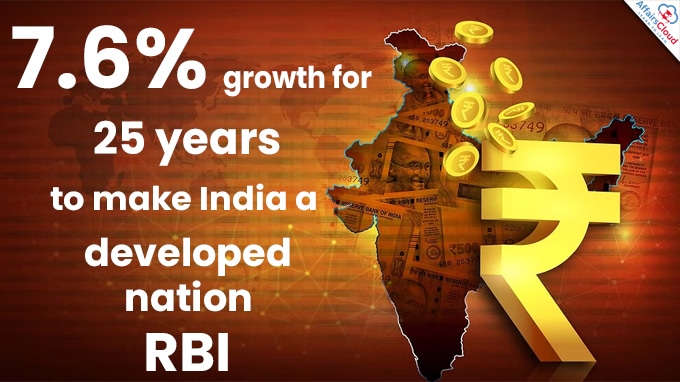
According to the article titled “India @ 100” published in Reserve Bank of India (RBI) Bulletin July 2023 published by RBI’s Economic Research Department, India needs to achieve an average annual real Gross Domestic Product (GDP) growth rate of 7.6% over the next 25 years to become a developed nation by 2047-48. This would require raising the current per capita GDP from USD2,500 to USD22,000, an increase of 8.8 times.
- This paper, authored by Harendra Behera, V. Dhanya, Kunal Priyadarshi, and Sapna Goel, is included in the RBI’s July 2023 issue of its monthly Bulletin, released on July 17, 2023. Click Here for full Monthly Bulletin
- Please note that this study does not represent the official view of the RBI.
Note: On India’s 75th year of independence (August 15, 2022), the Prime Minister (PM) Narendra Modi expressed his vision for the next 25 years to turn India into a developed nation by 2047.
Basis of Assessment:
There is no unique criterion to define a country as ‘developed’. However, as per World Bank (WB) standards, a country with a per capita income of US$ 13,205 or more in 2022-23 is classified as a high-income country. Meanwhile, the International Monetary Fund (IMF) classifies countries into Advanced Economies (AEs) and Emerging Market and Developing Economies (EMDEs) based on factors like per capita GDP, export diversification, and global financial integration.
- Since Per Capita Income (PCI) is the only common criterion, and the IMF doesn’t specify a threshold for AEs, the lowest recorded per capita income among AEs in 2022 (US$18,427 for Croatia) is used as a benchmark in this article. Also, the analysis assumes an Average Global Inflation Rate of 2% until 2047-48.
Highlights:
i.As per WB standards, India’s per capita income must be more than $21,664 by 2047.
- To achieve this target, the required real GDP compounded annual growth rate (CAGR) for India needs to be 7.6% during 2023-24 to 2047-48;
ii.As per IMF standards, India’s per capita nominal GDP must be more than US$ 30,351.
- To achieve this target, the real GDP CAGR required for India should be 9.1% during 2023-24 to 2047-48.
iii.So as per above, India’s per capita GDP in nominal terms would have to record a CAGR of 10.6 (9.1%) to become a high income country.
iv.It should be noted that the best India achieved over a period of consecutive 25 years in the past is a CAGR of 8.1% during 1993-94 to 2017-18.
What does India need to do to become a Developed nation?
i.India’s industrial sector should increase its share from the current 25.6% to 35% by 2047-48, and manufacturing should occupy 25% share in total value added.
- This would require the industrial sector to grow at a nominal CAGR of 13.4%.
ii.By sustaining a 13.3% growth rate in exports of goods and services (nominal), India can enhance its comparative advantage in services exports. This would increase the share of goods and services exports in GDP from 22.8% in 2022-23 to 30.5% by 2047-48.
iii.The agriculture sector would have to grow at a CAGR of 4.9% and the services sector by 13% in the coming 25 years to have a sectoral share of 5% and 60%, respectively, by 2047-48.
iv.India needs to adopt a multipronged approach to attain a sustainable path to development that includes structural and comprehensive reforms across sectors, investment in infrastructure, bolstering logistics, digitalizing the economy, and upskilling the labour force.
v.A Collaboration between the government, private sector, civil society, and citizens is also required.
vi.There is a requirement of upskilling of younger generation in the newage manufacturing and services sectors
Growth Drivers for India:
The Services sector will continue as the main driver of economic growth, however, India must also focus on widening its manufacturing base, and rebalance its economic structure by strengthening its industrial sector.
Recent Related News:
i.India, which presently holds the G20 Presidency, has entrusted IMF and the Financial Stability Board (FSB) to jointly prepare a technical paper on cryptocurrency assets. This technical paper could be used to formulate an all-inclusive policy to govern crypto assets.
ii.According to the RBI data, India’s Bank credit increased by 15% year-on-year (YoY) in the Financial year 2022-23 (FY23), against 9.6% YoY in 2021-22 (FY22).
About Reserve Bank of India (RBI):
i.It was established on April 1, 1935, in accordance with the provisions of the Reserve Bank of India Act, 1934.
ii.The Central Office of the Reserve Bank was initially established in Calcutta but was permanently moved to Mumbai in 1937.
iii.Though originally privately owned, since nationalization in 1949, the Reserve Bank is fully owned by the Government of India.
iv.Thus, 2023 marks the 75th year of public ownership of the Reserve Bank and its emergence as a national institution.




